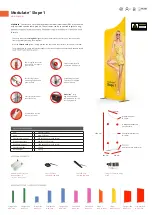
Commander 950 Wide-Band Oxygen Sensor
Quick Start Guide & Information
PN 534-188 (NTK Sensor Upgrade Kit)
PN 534-197 (Bosch LSU4 Sensor Upgrade Kit)
NOTE:
These instructions are meant specifically for the “Pro” Software and ECU Firmware.
NOTE:
More detailed information, including detailed tuning, is included in instruction manual P/N 199R10149-6/7. This manual
is intended to overview the installation and use of the Holley wide-band oxygen sensor.
Software & Firmware Version:
1. Make sure that your ECU has “Pro” firmware. To confirm this, view the firmware version by going into “About” and “Version”
in the software. The ECU must be connected to the laptop with the ignition “on” to view the firmware version. “Pro”
firmware is identified as version 3.0 and later. If your ECU does not have “Pro” firmware, you must send it in to Holley to
get it updated. If you purchased PN 534-188 or 534-197, a certificate is included to allow you to do so. Systems
manufactured in 2004 and later already have “Pro” firmware and software included.
2. Make sure you install the “Pro” software that is included in the 534-188 kit. PN 534-197 does not include the software and
manual. Both of these can be downloaded free of charge at www.holley.com.
Which Sensor Do I Use?
Both of these sensors will provide an accurate measurement of the air/fuel ratio of an engine, however the Bosch sensor has
some limitations. They are:
1. Although neither sensor is recommended for use with leaded fuels, the life of the Bosch sensor is much shorter than that of
the NTK sensor. Therefore, it is never recommended to use the Bosch sensor with any type of leaded fuel. The life
expectancy varies and is based on the lead content and other additives of a particular fuel.
2. The Bosch sensor should not be used in a high EGT (exhaust gas temperature) environment. The maximum exhaust gas
temperature the probe tip should see is 1560°F. The maximum the external case of the sensor should see is 1050°F.
Unless the sensor is very close to the cylinder head, or turbo, this should not be an issue for most applications. If the
Bosch sensor is used in a turbo application, it is recommended that the sensor is at least 18” downstream of the turbo. It
should be a minimum of 18” from the outlet of the exhaust to ensure an accurate reading. For applications above 10 PSI of
boost, the NTK sensor is recommended due to typical temperatures seen.
Sensor & Controller Mounting:
The controller can be mounted inside the vehicle or in the engine compartment. Keep it away from direct heat, direct road
debris, or direct water spray. A good place to mount it is on a firewall or fenderwell.
Sensor Placement & Installation:
The sensor should be mounted in the exhaust system at a point in which it reads at least one bank of cylinders, such as in the
header collector or just after it. See the 199R10149-6/7 manual for more information on the proper angle to mount it. The
sensor can also be mounted in an individual header tube for engines that have a particular cylinder that is known to be lean, and
the air/fuel ratio of that cylinder needs to be monitored.
Controller & Sensor Wiring:
The controller is designed to be plug-and-play with any existing Commander 950 wiring harness. The controller has an 8-pin
connector. The 534-188 kit includes and extension harness that is plugged into the controller and then the sensor. The 534-
197 kit does not have this extension cable. The pigtail on the Bosch sensor is long enough so that an extension is not needed in
most applications. If an extension cable is needed for either unit, it can be purchased under Holley PN 534-199. There is a 3-
pin weatherpack connector that plugs directly into the existing O
2
sensor connector (3 pin male weatherpack) on the main
harness (red, black, and purple wires). Plug these connectors together.
There are two more connectors coming out of the wide-band controller. The first connector has two orange wires. This is for
C.A.N. (Controller Area Network) communications that is not used on the Commander 950 at this time. The second connector is
a two-pin weatherpack with black wires that can be used to connect a gauge. A 2-1/8” gauge can be purchased from Holley
under Holley P/N 534-200 (for 3
rd
Gen. controllers).




















